ASUS MEMO Pad 7 Tablet Review (ME176CX)
At the Computex 2014 exhibition held in June, ASUS introduced many new devices on Intel's BayTail platform. The updated MEMO Pad 7 now works on the new 4-core Atom Z3745 processor with a frequency of 1.33 GHz. Also, the device has received a modern version of Android 4.4 KitKat. A nice addition will be a large selection of body colors, among which everyone can choose for themselves. Let's take a closer look at MEMO Pad 7 ME176CX.
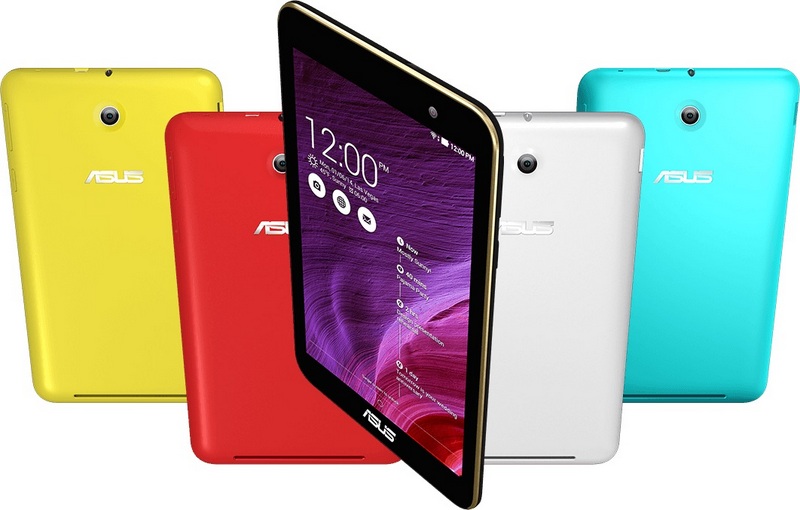
Software: Android 4.4 KitKat
Processor: Intel® Baytrail T Z3745 1.33 GHz (frequency under load up to 1.86 GHz), 4 cores
RAM: 1GB (1066 MHz) LPDDR3
Graphics: Intel HD Graphics
Screen: 7 "IPS, 1280x800 (WXGA) up to 10 simultaneous touches
Built-in memory: 8 / 16GB eMMC
Battery: 3910 mAh, polymer
Connectivity: 802.11b / g / n, BT 4.0, Miracast
Navigation: GPS / GLONASS
Sensors: gyroscope, compass, Hall sensor
Interfaces: microUSB (OTG), 3.5mm mini-jack for a headset, microSD / SDXC (up to 64GB)
Cameras: front 0.3 Mp, main 2 Mp
Colors: white, black, yellow, turquoise, red
Dimensions: 189.3x113.7x9.6mm
Weight: 295 g
')
ASUS MEMO Pad 7 comes in a small box, the size of the tablet itself:
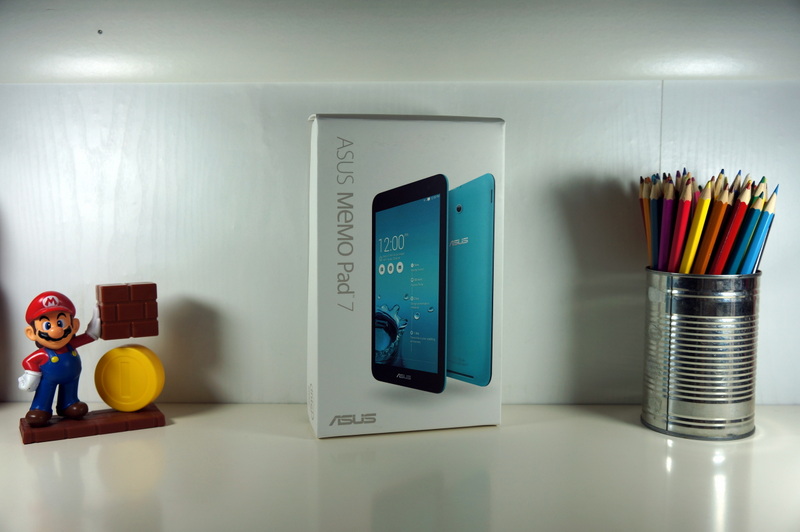
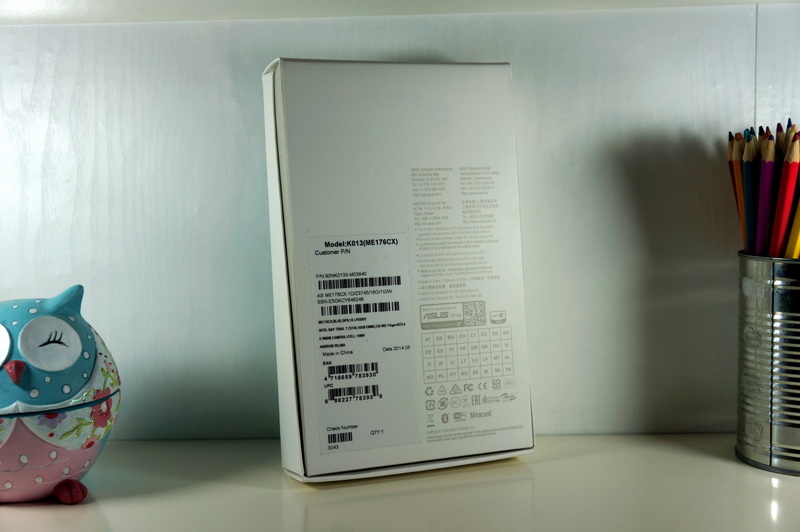
The latest ASUS tablet models come in packs with an unusual lid design, it looks interesting:

Standard equipment: charger and microUSB cable:


Charger power 7 watts. Current 1.35 A:

Good news - the complete absence of plastic glossy surfaces. Charging does not collect prints, the tablet is also completely matte:
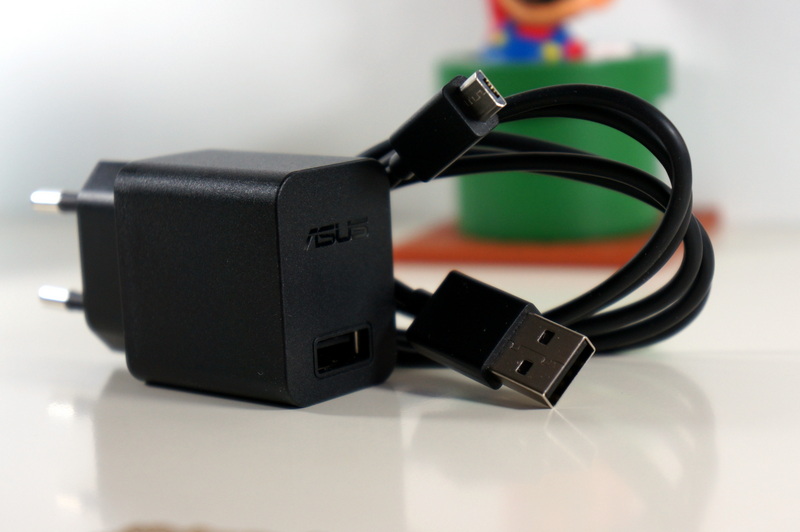
The design of the new MEMO Pad is reminiscent of last year’s models, a significant difference is the thinner frame of the display, on its sides its width is 9.75 mm. The case of the device turned out monolithic, everything fit exactly, no gaps and cracks. When squeezing there is no backlash and squeaks:

The dimensions of the device are 189 by 113 mm, the thickness is 9.6 mm. Weight is small, only 295 g.
Generally MEMO Pad is well balanced, very comfortable in the hand.
The front part is completely covered with glass, the ASUS logo is located under the screen. There are no hardware buttons, only functional buttons at the bottom of the screen:

The back panel is made of plastic. The coating is dull, slightly rough and does not collect fingerprints:

The camera is located in the upper part, there is an influx around the lens, which protects the camera from scratches when the tablet is on the table. Under the camera is another ASUS logo, and on the opposite side are two speakers:
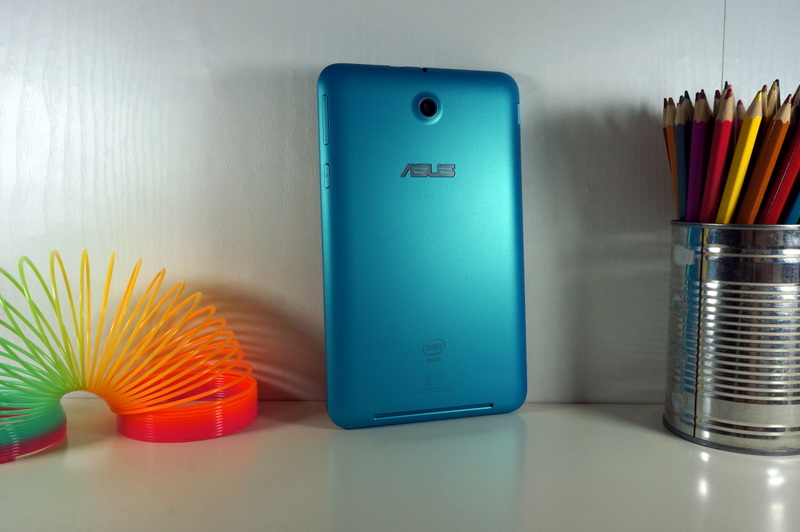
An interesting feature that makes MEMO Pad among the huge mass of tablets - the presence of a wide range of color design. The following colors will be available in our country: white, black, yellow, turquoise and red.
Consider the interfaces available to us. At the top, there is a 3.5 mm mini jack for connecting a headset, microUSB for synchronizing with a computer and charging. Also on the top is the microphone:

The connector supports OTG, i.e. You can connect flash drives and various peripherals. Unfortunately, the microUSB-OTG cable is not included, it will have to be bought separately.
The right side is the volume rocker and the screen unlock button:

On the left side is a slot for micro SD memory cards. Supported cards up to 64 GB SDHC standard:

As usual, the index of the model indicates the size of the screen diagonal. The resolution is standard: 1280 by 800 pixels. The picture looks decent, the text is well read, pixelation is imperceptible, PPI is 215 pixels per inch:

A huge plus is the IPS matrix with LED backlight. The screen has bright and saturated colors, wide viewing angles:

The sun will have to set the maximum brightness, and do it manually - there is no light sensor. The anti-reflective coating does not do its job too well, bright light sources are well reflected in the screen:


The sensor works fine, all touches are instantly worked out without delay. Up to 10 simultaneous touches are supported:

The tablet has two cameras, 0.3 megapixel front for video calls and the main one for 2 megapixels. Autofocus is not, the quality of shooting is satisfactory, which is explained by the budget of the device:


Although the tablet received an ordinary camera module, the firmware included a full-fledged photo application with many effects similar to those used in Zenfone phones:
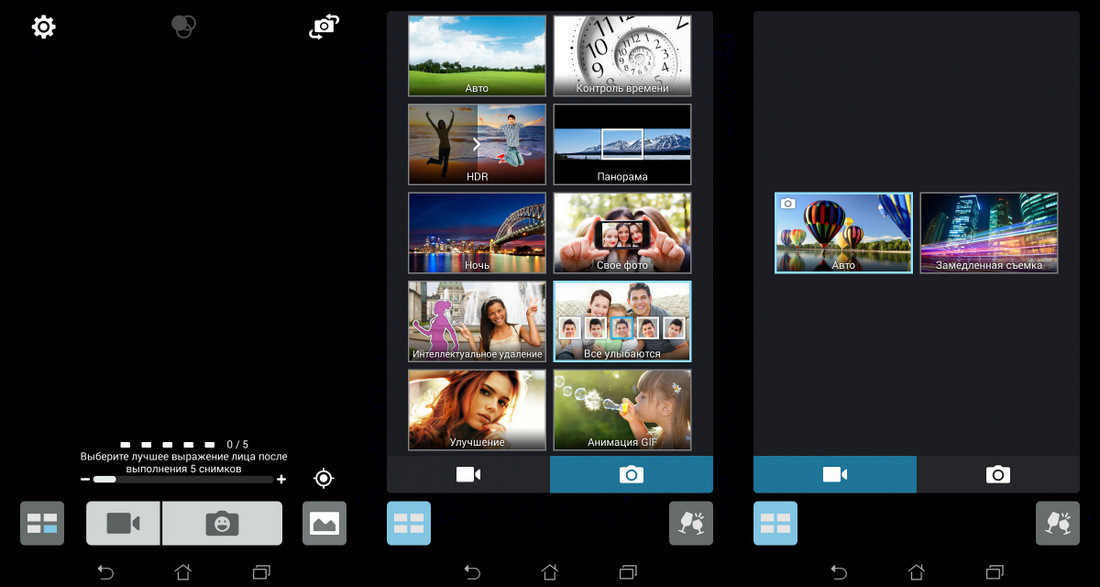
Intel's new Baytrail platform performed well in other ASUS mobile devices. Intel T Z3745 has good performance and high runtime. 4-core processor clocked at 1.33 GHz, made on the 20-nm process technology. With a high load, it can increase the frequency to 1.86 GHz, and in non-resource-intensive applications, the frequency, on the contrary, decreases. RAM 1 GB and LPDDR3 standard has a higher speed and increased energy efficiency.
The tablet hardware is not inferior to devices based on other platforms. In games, MEMO Pad shows good performance and a nice picture.
Video with the launch of games
Benchmark results:


Wi-Fi behaves rather strangely, the speed did not rise above 10 Mbit / s. Although other devices showed confident 30-40 Mbit / s. Perhaps this is a single case or a problem with the firmware.
The built-in navigation chipset can simultaneously work with GLONASS and GPS. Capture of satellites is fast, reception is sure, the tablet can be recommended to use as a navigator:

The tablet is running a modern operating system Android 4.4 KitKat. All updates "fly through the air", when turned on, the device immediately offered to update the firmware. The interface works smartly, there are no slowdowns and lags, the lists scroll smoothly.
The MEMO Pad uses a proprietary graphical shell called ZenUI. ASUS designers proposed to simplify the interface to an intuitive view without losing functionality. In general, ZenUI looks nice, icons have become simpler and follow modern trends in the user interface. Standard applications are also changed in favor of the overall concept. The interface leaves only pleasant sensations.
Interface Screenshots:
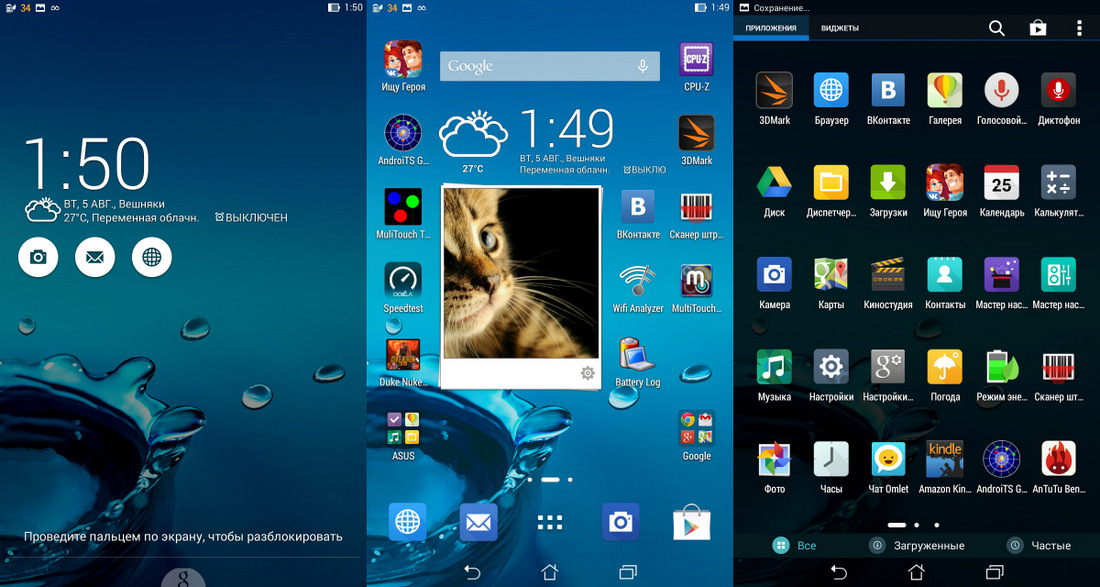
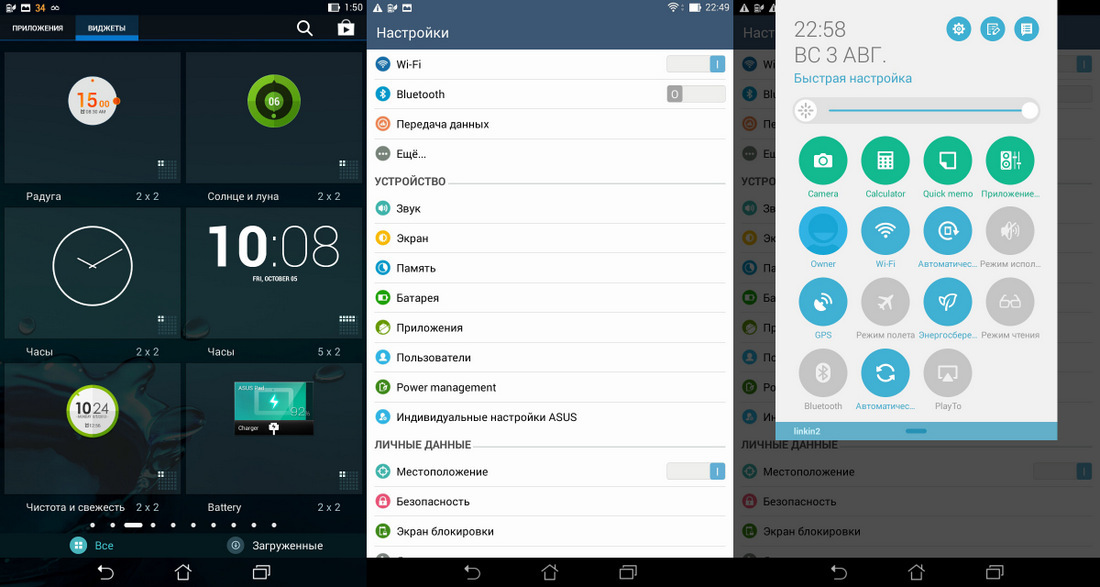

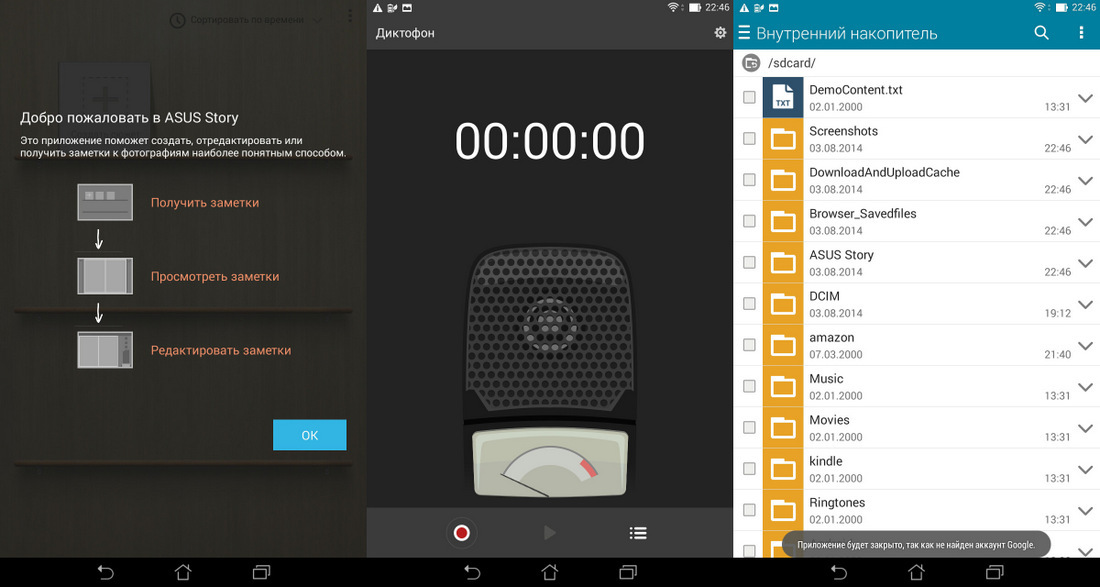


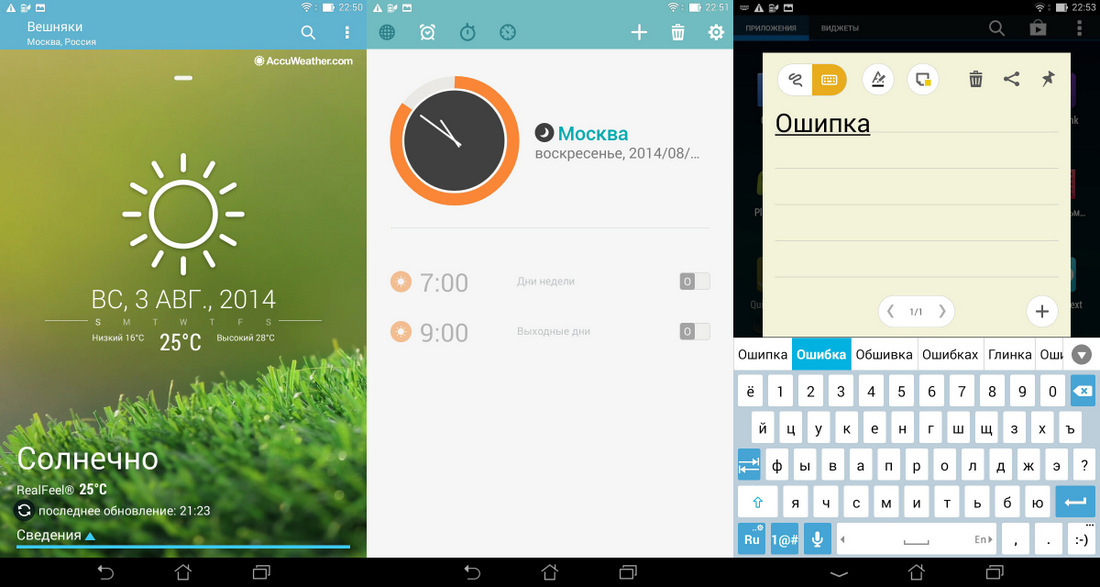
Capacity of the built-in polymer battery 3910 mAh.
Using a special section in the menu, you can flexibly configure the system for a longer operation of the device.
In power saving mode, the machine will turn on the wireless connection only with the active screen. Using the optimized mode, I did not notice any restrictions, everything works as usual. You can flexibly configure the backlight for video or sites, determine the permissions of instant messengers to use the Internet:
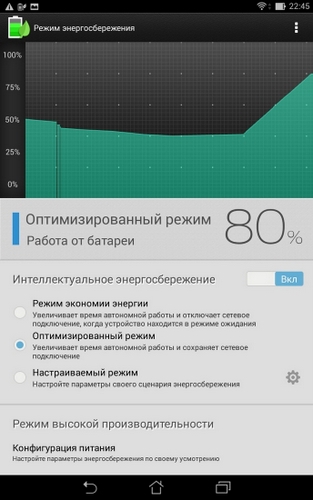
Video mode: medium brightness, Wi-Fi off, tablet worked for 7 hours.
Reader mode: minimum brightness, Wi-Fi is disabled, the tablet lasted 8.5 hours.
With constant use of the Internet, watching videos and reading, the charge lasts for 6.5 hours.
It takes about 2 hours to fully charge the battery, provided you use the original charge:
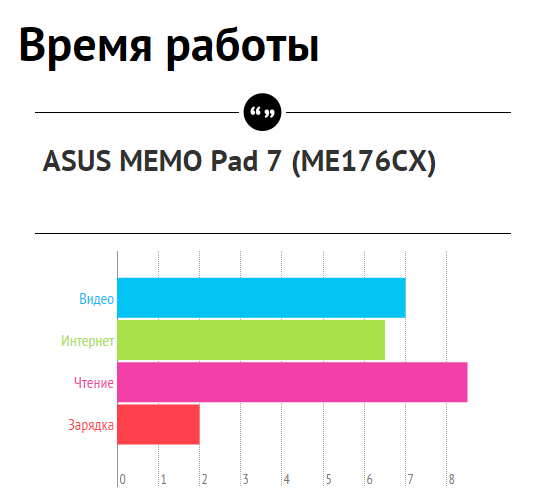
The updated MEMO Pad 7 will be a good helper for most tasks. The tablet received a compact size and light weight. Productivity will be enough for all modern applications. Energy efficient processor allows you to watch videos up to 10 hours without recharging. In general, the device perfectly fulfills its price and demonstrates a good indicator of "price / quality."
Recommended price is 5990 rubles.

 Specifications
Specifications
Software: Android 4.4 KitKat
Processor: Intel® Baytrail T Z3745 1.33 GHz (frequency under load up to 1.86 GHz), 4 cores
RAM: 1GB (1066 MHz) LPDDR3
Graphics: Intel HD Graphics
Screen: 7 "IPS, 1280x800 (WXGA) up to 10 simultaneous touches
Built-in memory: 8 / 16GB eMMC
Battery: 3910 mAh, polymer
Connectivity: 802.11b / g / n, BT 4.0, Miracast
Navigation: GPS / GLONASS
Sensors: gyroscope, compass, Hall sensor
Interfaces: microUSB (OTG), 3.5mm mini-jack for a headset, microSD / SDXC (up to 64GB)
Cameras: front 0.3 Mp, main 2 Mp
Colors: white, black, yellow, turquoise, red
Dimensions: 189.3x113.7x9.6mm
Weight: 295 g
')
 Equipment
Equipment
ASUS MEMO Pad 7 comes in a small box, the size of the tablet itself:


The latest ASUS tablet models come in packs with an unusual lid design, it looks interesting:

Standard equipment: charger and microUSB cable:


Charger power 7 watts. Current 1.35 A:

Good news - the complete absence of plastic glossy surfaces. Charging does not collect prints, the tablet is also completely matte:

 Appearance
Appearance
The design of the new MEMO Pad is reminiscent of last year’s models, a significant difference is the thinner frame of the display, on its sides its width is 9.75 mm. The case of the device turned out monolithic, everything fit exactly, no gaps and cracks. When squeezing there is no backlash and squeaks:

The dimensions of the device are 189 by 113 mm, the thickness is 9.6 mm. Weight is small, only 295 g.
Generally MEMO Pad is well balanced, very comfortable in the hand.
The front part is completely covered with glass, the ASUS logo is located under the screen. There are no hardware buttons, only functional buttons at the bottom of the screen:

The back panel is made of plastic. The coating is dull, slightly rough and does not collect fingerprints:

The camera is located in the upper part, there is an influx around the lens, which protects the camera from scratches when the tablet is on the table. Under the camera is another ASUS logo, and on the opposite side are two speakers:

An interesting feature that makes MEMO Pad among the huge mass of tablets - the presence of a wide range of color design. The following colors will be available in our country: white, black, yellow, turquoise and red.
 Interfaces
Interfaces
Consider the interfaces available to us. At the top, there is a 3.5 mm mini jack for connecting a headset, microUSB for synchronizing with a computer and charging. Also on the top is the microphone:

The connector supports OTG, i.e. You can connect flash drives and various peripherals. Unfortunately, the microUSB-OTG cable is not included, it will have to be bought separately.
The right side is the volume rocker and the screen unlock button:

On the left side is a slot for micro SD memory cards. Supported cards up to 64 GB SDHC standard:

 Screen
Screen
As usual, the index of the model indicates the size of the screen diagonal. The resolution is standard: 1280 by 800 pixels. The picture looks decent, the text is well read, pixelation is imperceptible, PPI is 215 pixels per inch:

A huge plus is the IPS matrix with LED backlight. The screen has bright and saturated colors, wide viewing angles:

The sun will have to set the maximum brightness, and do it manually - there is no light sensor. The anti-reflective coating does not do its job too well, bright light sources are well reflected in the screen:


The sensor works fine, all touches are instantly worked out without delay. Up to 10 simultaneous touches are supported:

 Camera
Camera
The tablet has two cameras, 0.3 megapixel front for video calls and the main one for 2 megapixels. Autofocus is not, the quality of shooting is satisfactory, which is explained by the budget of the device:


Although the tablet received an ordinary camera module, the firmware included a full-fledged photo application with many effects similar to those used in Zenfone phones:

 Performance
Performance
Intel's new Baytrail platform performed well in other ASUS mobile devices. Intel T Z3745 has good performance and high runtime. 4-core processor clocked at 1.33 GHz, made on the 20-nm process technology. With a high load, it can increase the frequency to 1.86 GHz, and in non-resource-intensive applications, the frequency, on the contrary, decreases. RAM 1 GB and LPDDR3 standard has a higher speed and increased energy efficiency.
The tablet hardware is not inferior to devices based on other platforms. In games, MEMO Pad shows good performance and a nice picture.
Video with the launch of games
Benchmark results:


Wi-Fi behaves rather strangely, the speed did not rise above 10 Mbit / s. Although other devices showed confident 30-40 Mbit / s. Perhaps this is a single case or a problem with the firmware.
The built-in navigation chipset can simultaneously work with GLONASS and GPS. Capture of satellites is fast, reception is sure, the tablet can be recommended to use as a navigator:

 Software
Software
The tablet is running a modern operating system Android 4.4 KitKat. All updates "fly through the air", when turned on, the device immediately offered to update the firmware. The interface works smartly, there are no slowdowns and lags, the lists scroll smoothly.
The MEMO Pad uses a proprietary graphical shell called ZenUI. ASUS designers proposed to simplify the interface to an intuitive view without losing functionality. In general, ZenUI looks nice, icons have become simpler and follow modern trends in the user interface. Standard applications are also changed in favor of the overall concept. The interface leaves only pleasant sensations.
Interface Screenshots:







 Battery and working time
Battery and working time
Capacity of the built-in polymer battery 3910 mAh.
Using a special section in the menu, you can flexibly configure the system for a longer operation of the device.
In power saving mode, the machine will turn on the wireless connection only with the active screen. Using the optimized mode, I did not notice any restrictions, everything works as usual. You can flexibly configure the backlight for video or sites, determine the permissions of instant messengers to use the Internet:

Video mode: medium brightness, Wi-Fi off, tablet worked for 7 hours.
Reader mode: minimum brightness, Wi-Fi is disabled, the tablet lasted 8.5 hours.
With constant use of the Internet, watching videos and reading, the charge lasts for 6.5 hours.
It takes about 2 hours to fully charge the battery, provided you use the original charge:

 Conclusion
Conclusion
The updated MEMO Pad 7 will be a good helper for most tasks. The tablet received a compact size and light weight. Productivity will be enough for all modern applications. Energy efficient processor allows you to watch videos up to 10 hours without recharging. In general, the device perfectly fulfills its price and demonstrates a good indicator of "price / quality."
Recommended price is 5990 rubles.
Source: https://habr.com/ru/post/235685/
All Articles